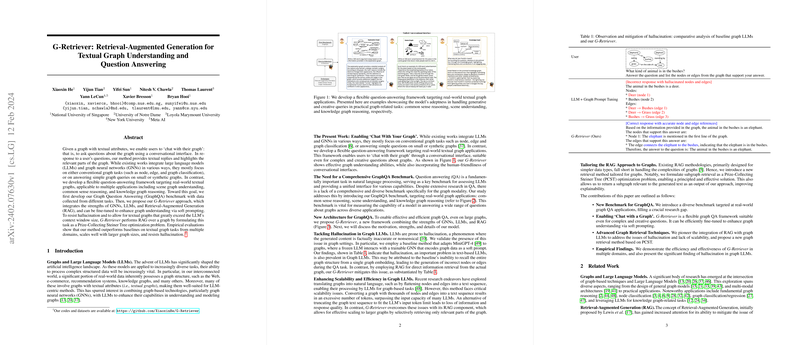G-Retriever: Retrieval-Augmented Generation for Textual Graph Understanding and Question Answering
The article introduces "G-Retriever," a novel framework designed for retrieval-augmented generation (RAG) to enhance the understanding and question-answering (QA) capabilities over textual graphs. With the integration of Graph Neural Networks (GNNs) and LLMs, the proposed approach aims to enable a conversational interface through which users can seamlessly interact with and inquire about complex real-world textual graphs.
Key Contributions
GraphQA Benchmark
The paper addresses a significant gap in QA benchmarks tailored to graph modalities by presenting the GraphQA benchmark. This benchmark encompasses a diverse set of datasets: ExplaGraphs for commonsense reasoning, SceneGraphs for visual question answering, and WebQSP for knowledge graph-based multi-hop question answering. The standardization and processing of these datasets into the GraphQA format allow a comprehensive evaluation of models in answering a wide array of questions related to real-world graph applications.
G-Retriever Architecture
G-Retriever is built upon the synergy of GNNs, LLMs, and RAG, fine-tuned to provide a robust QA framework that scales to larger textual graphs and resists hallucinations.
- Indexing: The approach begins with encoding node and edge attributes using a pre-trained LM (SentenceBert), creating embeddings stored in a nearest-neighbor data structure for efficient query processing.
- Retrieval: Utilizing cosine similarity, the system retrieves semantically relevant nodes and edges from the graph, conditioned on the query.
- Subgraph Construction: The retrieval task is cast as a Prize-Collecting Steiner Tree (PCST) optimization problem to construct an optimally connected subgraph, encompassing relevant nodes and edges while controlling for manageable graph size.
- Answer Generation: A GAT-based graph encoder models the retrieved subgraph. The output is projected into the LLM's vector space and combined with the query and a textualized form of the graph for final answer generation through a frozen LLM, augmented via soft prompting.
Experimental Evaluation
The empirical evaluation affirms G-Retriever's superior performance across the datasets in the GraphQA benchmark.
Main Results
The method outperforms baseline and state-of-the-art models in various configurations (Inference-Only, Frozen LLM + Prompt Tuning, and Tuned LLM):
- On ExplaGraphs, SceneGraphs, and WebQSP datasets, G-Retriever achieved improvements (e.g., 47.99% in ExplaGraphs under prompt tuning) relative to baseline models.
- The integration of RAG and graph-specific optimizations significantly enhanced model efficiency, reducing the average number of tokens and nodes processed by up to 99% on larger graphs like those in the WebQSP dataset.
- G-Retriever demonstrated a substantial reduction in hallucinations, confirming its effectiveness in generating factually consistent answers by directly retrieving accurate graph information.
Ablation Study
The paper illustrates the contributions of each component in G-Retriever, revealing that omitting crucial elements, such as the graph encoder or textualized graph, results in considerable performance drops.
Implications and Future Work
Practical Implications
G-Retriever’s capability to handle complex and large-scale textual graphs extends its applicability to diverse fields including knowledge management, e-commerce, and scene analysis, thus being adaptable to numerous real-world applications that involve intricate graph-structured data.
Theoretical Implications
The incorporation of RAG into the graph domain underscores the effectiveness of retrieval-based approaches beyond conventional language tasks, presenting a transformative strategy that mitigates hallucination issues prevalent in both text and graph-based models.
Future Developments
Future work could delve into dynamic, trainable retrieval mechanisms within the RAG framework, potentially further optimizing the retrieval and generation process. Enhanced retrieval strategies may facilitate a more flexible and adaptive retrieval schema, catering to an increasingly broader array of graph-related tasks.
Conclusion
The presented work signifies a forward step in graph-based QA by blending graph-neural and LLMs, emphasizing the feasibility and advantages of the RAG approach in large and complex textual graph settings. G-Retriever's design and empirical success highlight its potential for advancing both human-computer interaction and automated understanding within graph-related AI applications.
